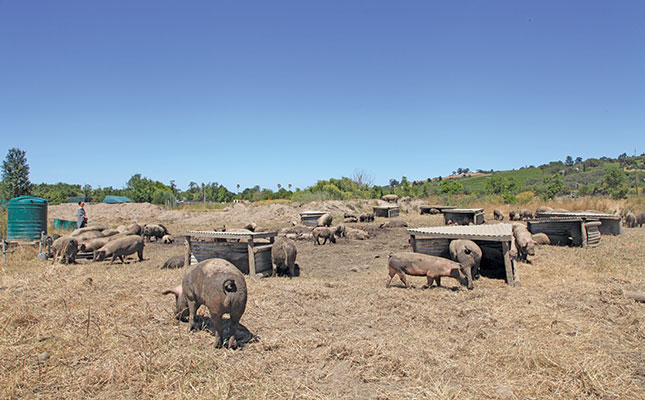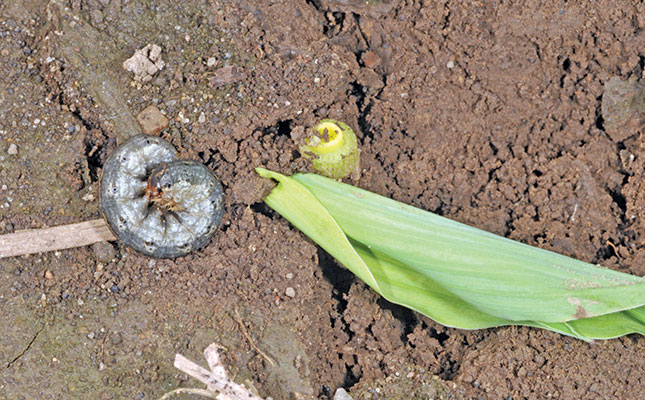
Photo: Glenneis Kriel
Angus McIntosh, a champion of regenerative agriculture in South Africa, has applied biodynamic practices to beef, broiler and egg production since he began farming on Spier Wine Estate near Stellenbosch in 2008.
Almost from inception, his customers asked him to add pork to his offering, but it was only in 2016 that he decided to do so.
“My clients were looking for pork produced outside, in the same way as my beef, broilers and eggs,” he says.
He emphasises that he is not talking about ‘free-range’ livestock, a term which, according to him, has been grossly abused to make money and inflate prices. Instead, he carefully controls his animals’ movements to make the most of their foraging habits.
Mimicking herds of game
“We use high-density strip grazing, which means the animals are systematically moved over 123ha of irrigated pastures on the farm, mimicking the way a herd of game range through the veld when they have access to large, open spaces,” he explains.
The idea behind the system is for pasture to be grazed short enough to remain palatable, and then to give it at least six weeks to recover from grazing. Broilers are moved daily to a new patch of pasture, whereas cattle are moved up to three times a day, depending on the quality of the pasture. The pigs, because of their destructive foraging habits, are only allowed on poorer pastures destined for re-establishment. They are moved systematically every three to five days over this area.
“Pigs are like the ultimate tractor, except they fertilise the soil while loosening it and don’t have any breakable parts, nor cause compaction. In addition, you can eat them once they’ve finished working,” McIntosh says.
He was, nevertheless, initially hesitant to include pigs in his production system.
“Outdoor pig farming presents huge engineering challenges, because feeders, shades and drinkers need to be strong enough to prevent breakages, yet light enough to be moved easily,” he explains.
He only became convinced that outdoor pig production might work in his system after seeing in April 2016 how pigs had improved the soil fertility on Hendrik O’Neil’s farm.
“Hendrik had long been practising high-density grazing with cattle on his 12 000ha farm in Zimbabwe. After losing his farm, he ended up on 20ha of land near Bela-Bela in Limpopo. The land was too small for cattle, so he switched to high-density grazing with pigs.”
Basing his system on O’Neil’s model, McIntosh restricts pig movements through the use of portable solar-powered electric fencing. He uses a Gallagher S40 solar-powered electric energiser, with the fence consisting of three 2,5mm TuboLine wires on intermittently spaced galvanised posts.
Shade is provided by triangular mobile shelters covered with Zincalume, lightweight corrugated sheeting that remains cool even when the temperature rises above 40°C.
He initially struggled to find whey drinkers strong enough, as the pigs tended to break them and bite the nipple drinkers, causing blockages. The use of Class 12 PVC pipes as drinkers solved the problem.
Sourcing weaners
McIntosh launched his pig enterprise with 30 weaners, including Large Whites, Landraces and Durocs. “As with our cattle and broilers, we didn’t go for a hardy, indigenous breed, but commercial breeds that were well recognised for good growth and the quality of their meat,” he says.
Today, he keeps between 150 and 200 pigs, which are slaughtered at about nine months, with a carcass weight of 120kg. About eight pigs are slaughtered a week. New weaners are bought in from farmers practising similar agricultural methods. Boar taint is prevented by buying only castrated boars, or only females.
McIntosh tried to breed his own piglets during the first two years of production. In the first year, he used sows produced on the farm, reasoning that they would have adapted to outdoor conditions, but they proved to be poor mothers, resulting in high piglet mortalities.
In the second year, he bought pregnant sows from a commercial farm, planning to use the surviving daughters for future piglet production. However, he decided against the idea when he realised that he would need a permanent employee to look after the division.
“My business is too small to have someone full-time on this,” he explains.
According to McIntosh, it is far more diffcult to produce piglets than calves.
“With cattle, you merely need to leave a bull with a group of cows for 50 days once a year, and cows that have not taken are slaughtered three months later. In contrast, pigs have a gestation period of 116 days, with piglets generally weaned when they’re about 28 days old, whereas we wean them at 10 weeks. The sows then go on heat after five days and again 21 days later.”
In addition to these complicated management practices, McIntosh would need to find sows with good mothering abilities, a problem O’Neil has overcome over many years by selecting sows for this quality. McIntosh would also need at least four boars.
Feeding
Pigs, unlike cattle, cannot survive off pastures and licks alone. McIntosh gives his pigs a specially mixed grower ration that does not contain any genetically modified organisms or glyphosates.
“Profile Feeds has gone out of its way to accommodate me with this feed mix, even though I have such a small operation,” he says.
In addition to this, the animals are fed egg pulp from broken eggs from the poultry operation, and whey from a nearby cheese factory. Small volumes of non-meat waste from the Spier restaurants are also channelled to them.
“Feed represents our greatest cost. If you want to farm pigs, you need to look for nutrient-dense food that’s available nearby. Feeding cabbages to pigs won’t fill their stomachs,” he says.
The pigs, like all the other animals on the farm, receive a free-choice mineral lick to address mineral imbalances. Three separate licks are provided:
- Khoisan unwashed salt and charcoal;
- Pat Coleby mix (2 kg dolomitic lime, and 1kg each of copper sulphate, sulphur dust and kelp);
- One part zinc sulphate to three parts salt.
McIntosh says zinc is especially important for pigs grazing on pasture, as deficiencies may lead to poor growth and appetite.
The pigs are not vaccinated, yet hardly ever suffer any health problems. Antibiotics are only used curatively and when absolutely necessary. McIntosh estimates that antibiotic treatment is limited to about one case every six weeks. The pigs receive a dewormer along with their food every second feed.
Value-adding
The pig division has only started breaking even this year, with the past couple of months looking even better, according to McIntosh. He adds that the venture makes economic sense only because he adds value to the meat.
The pigs are slaughtered at Winelands Pork and the meat is processed on the farm. The viability of the enterprise will be further improved by June, when McIntosh opens a new butchery on Spier, increasing processing capacity to 22 pigs per week.
“We’re focusing on the production of high-value meat, such as charcuterie, for the best possible returns. Our product is unique as it contains no added nitrates or nitrites,” he says.
When deciding on whether to keep pigs or not, farmers should consider the eco-benefits of pig production, he emphasises, adding that he achieved good results when experimenting with pigs and vegetable production in October. The pigs were allowed to ‘plough’ and ‘fertilise’ the land for a few weeks before summer squashes, such as watermelon, melon and pumpkin, were planted.
While he has not done so again due to water limitations, he is considering expanding the trial by either allowing the pigs to graze the vegetable stalks after the harvest, or working the leftover material back into the soil as a cover crop.
McIntosh says the pigs significantly improve the soil they work. When he took samples earlier this year, he found that the area where the pigs had grazed had a 24% higher carbon content than the area, just metres away, where they had not grazed.
He says that farmers often look only at the cost of production and earnings when considering the financial viability of farming a particular animal or crop.
“You should also consider the potential of that animal or crop to help fertilise and restore the soil.”
Email Angus McIntosh at [email protected].











